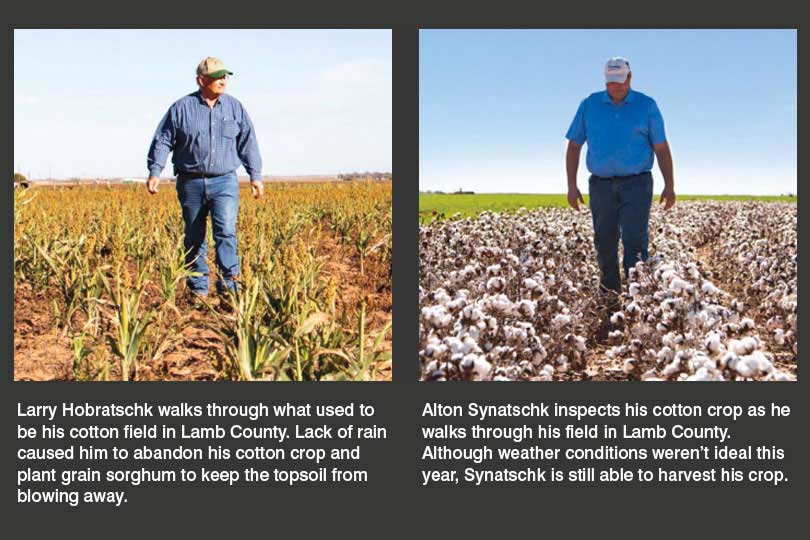By Jennifer Dorsett
Field Editor
It wasn’t the best of times for any Texas cotton farmer, but 2018 was the worst of times for some. Lamb County farmers Larry Hobratschk and Alton Synatschk may live in the same county and grow the same crop, but they had drastically different outcomes this year.
Where one farmer had some, the other had none.
“The cotton just didn’t come up,” Hobratschk said. “I’ve always had cotton here. In spots, we got hailed out, or had a little bit of drought, but nothing like this year. This is the worst year we’ve ever had in 40 years.”
Lamb County received only two inches of rainfall from October 2017 until this August, according to Hobratschk. Although he has irrigation, Hobratschk’s wells don’t pump enough water to sustain cotton plants without some help from Mother Nature.
Most of the dryland acres in Lamb County failed. Some of the irrigated ones did, too.
Texas High Plains’ main water source is the Ogallala Aquifer. The Ogallala has steadily declined for the past several years, slowing down some wells’ pump rates and drying up others.
“We have to have rain to go with the irrigation I do have,” Hobratschk said. “We tried to substitute rainfall with irrigation, but there just wasn’t enough to get it up and get it going. After a couple of weeks, we just abandoned everything.”
Haygrazer and grain sorghum were planted in the empty cotton fields to keep the topsoil from blowing away.
Although an unusually large amount of rain came in the fall, it was too late to help him with this year’s cotton. But Hobratschk is still grateful.
“At least we’re getting some moisture to work with,” he said. “We’re getting moisture for the cover crop and maybe some for next year.”
Even though it was one of the worst years he’s ever seen, Hobratschk looks forward to the future and another year of farming. That’s just how it works out sometimes, he said.
“We just ask that people keep us in their prayers,” Hobratschk said. “It’s just the way of life for us. If it rains and the weather cooperates, then we’ll make a crop. If it doesn’t, like this year, we don’t make a crop. It’s just not a guarantee.”
In the northern part of the county, Synatschk was facing the same issues. Hot, dry days. Faltering irrigation wells. But most of his cotton survived.
“We just didn’t have enough irrigation to make some of our cotton work this year,” Synatschk said. “But from what we do have, what we’ve stripped so far and ginned, it’s yielding very well and has a good quality. Some of the hotter, dryer years, what we lack in quantity, we’ll make up for in quality.”
The area’s average yield is two-and-a-half bales per acre.
“One bale per acre will not make your costs back,” Synatschk said. “There is some insurance depending on where your yields are at and what level of coverage you have. They may kick in and help you a little bit at that level, but not much. One bale won’t get it done this year.”
But he’s not complaining. Synatschk realizes he’s fortunate to have cotton at all after the wild ride farmers saw in 2018.
It was one that led to difficulties at harvest for Synatschk as a flood of downpours put him behind.
The rain was too late to the help the crop and kept area farmers out of the field.
Synatschk feels for his fellow cotton farmers who didn’t make a crop this year. But he knows they won’t give up.
“They won’t act like it in a coffee shop, but farmers are pretty optimistic,” he said. “They have to be, because things don’t always look good from the start. Sometimes they work out, and sometimes they don’t, but they try again next year because it’s something they love doing.”

